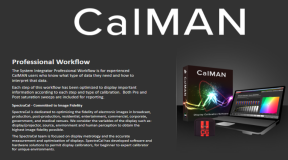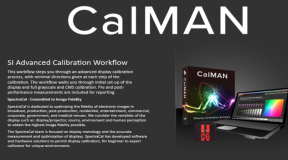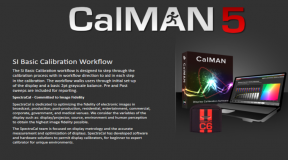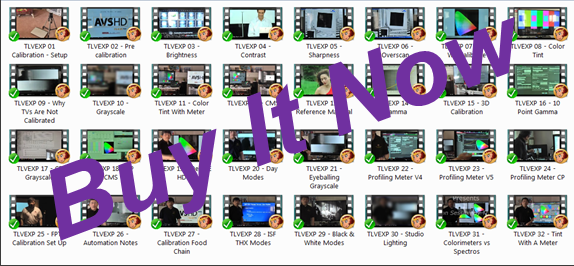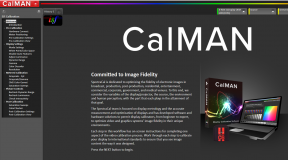ISF Seminar Review by Michael TLV
Tip by Michael TLV: (circa 1999/2000) “I won’t pretend that there is supposed to be any order to what I am about to write about, but there will be a basic structure and I will try to separate out the factual items from things that are strictly subjective from my perspective.
I went into this seminar as quite the skeptic, questioning whether or not it might be worth my time and hard earned money. While I don’t come out of this as a firm believer, I do now have a whole new respect for just what the ISF (Joel Silver & Jim Burns) is trying to accomplish in the industry as a whole. The seminar was very professionally organized and very slick. Both JS and JB are great spokespeople who know how to talk to this crowd. What I got out of the seminar was probably much different than what the others in the room got from it though. I went in with a number of questions about the entire calibration process that had nagged both myself and many others in the HT enthusiat community.
The idea that this was money well spent for me … well, let’s put it this way, I believe that it was worth the cost just to talk at length with Joel Silver one on one regarding all these questions that I had. It was worth it to meet others in the industry. JS has this personable style to the way he talks that just makes you believe that he really is passionate about his work.
Now I might caution that JS is not God and do not refer to him as such, but in the area of image calibration for this industry, he’s got a book named after him. The “Book of Joel.” The presentation was not infalible as some items presented (Just a few) were not quite as up to date as they could have been.
Well, then, time to get down to it. First some facts to set up the environment of the Seminar.
The seminar occurred on June 1 & 2, 2000 at the Doubletree Inn in Aurora, CO. It consisted of two seven hour sessions each day. The three ISF representatives present were:
- Joel Silver (Primary presenter on Calibration items)
- Jim Burns (Primary presenter on Digital Television items)
- Jim Doolittle (Set up and technical support)
The seminar was held in an amphitheater type setting in the hotel. The equipment used in the demontrations and presentations were:
- CRT FPTV (I don’t pretend to know the model numbers.)
- DLP projector
- LCD projector
- Two 32” Toshiba directviews
- Hotel’s 27” Proscan (Dated, but not as bad a performer as originally expected.)
People in attendance: Approximately 30 with two from Belgium of all places. (This gets into the subjective area so I will put it in parenthesis. From what I could gather the breakdown of this audience was pretty much 25 HT installers, 4 Toshiba Reps and 2 Calibrators. Doesn’t add up huh? Well one guy was there for the third time and he did both already (Also helped to set up the seminar logistics). So this puts me as a stranger in a strange land. It was harder to get into the conversations of the others because it was all tech talk and here I was without a common point of reference. But when you introduce yourself as a Calibrator … well, let’s just say that I handed out quite a few tips to these people, primarily telling them to frequent Home Theater Forums like the DTF to help them in their calibration quests. As well as the KeohiHDTV site. Most in the audience also worked only on FPTVs with little or no apparent experience with RPTV’s and Direct view sets.)
Demonstration Material:
- Video Essentials
- AVIA
- Fifth Element (Mangalore as Waiter)
- Casablanca
- Star Trek Insurrection (Opening Credit Scroll)
Sencore Advertising Pitch for their analyzers … and the Sencore sponsored lunch on Day two.
Freebies: (Not quite free, but unexpected bonuses.)
- Magazines … Free Samples of Home Theater, Widescreen Review, SGHT, AV Interiors
- Brochure on D6500 light for behind the TVSencore Chromaticity Chart … (Nice)
- AVIA
- D6500 fluorescent Bulb
- Robust colour filter plates (RGB) similar to the blue filter included in A Video Standard Laserdisc from so long ago.
- Very well organized Seminar Book
Well, let’s get into the nitty gritty of what all went on. I ended up with some eight pages of notes and I figure that I will just lay them all down in point form so there is some chronologic order to all this. I’ve stayed away from the really technical stuff since there is no sense reiterating that. I’ve kept all the things that I think most here would find interesting. The stories … the tragedies … Also interspersed are the questions that I asked JS and JB either one on one or during the presentation. I thank them for putting up with me and the list of questions. (Blame the HT community … no wait, blame Canada. Yeah, that’s the ticket.) There has to be one in every crowd and I was the “Jerk” this time. Gotta make them earn my money, though I don’t think they will be over anytime soon to mow my lawn.
My notes might actually resemble x’s and o’s like Gilligan and the beauty contest.
Notes from the Seminar:
- JS mentions off hand the CEO’s of companies where he has done HT set ups. Then he brings up the term “CFO” who are the bosses of the CEO’s. (Chief Female Officer) This being a decidedly male crowd, expected. Only one lady in attendance,, but she was part of the local organizing committee, and probably a receptionist for that company.
- DVDO’s ISCAN might not be recommended for FPTV systems because of design compromises in the unit’s internal sharpness setting. Too much edging as can be seen on FPTV’s. JS said that this was a design choice by the DVDO people when they had to figure out who their primary market would be. They chose RPTV’s. JS says the ISCAN is a great addition for RPTV’s, just not FPTV’s. (It kind of makes sense as the device is only $700)
- In response to my question about Optimal Contrast settings, Jim Burns showed a way to determine the optimum contrast setting for a TV, as opposed to the maximum do not exceed point determined in the various test discs. The plate to use is the pluge with grayscale bars. This was not perfect, but it was a start. I need to test it out on a few sets first. It may not be appropriate for sets with line doubling/progressive capabilities.
- In response to my question to JS about the Philips Analyzer and light readings off a RPTV, JS said that the lenticular screen would be messing with the light reading when trying to get a Ft-L reading. The Philips and others, I believe, were not designed to take accurate light readings off the lenticular screen. In this case, a recent reading of 3.7 ft-l from the 100 IRE window of my set actually was in the order of 10 ft-l. JS pretty much said that the reading needs to be tripled. So my maximum light output reading of 8.8 ft-l was actually about 25 ft-l. Exactly where it should be.
- From JS, lenticular screens on RPTV’s are a major limiting factor in the overall resolution of the image displayed. The spacing of the ridges affects the visible resolution. Diffusion screens are better here since they don’t have the lenticular structure. The finer the lenticular structure, the less light output.
- JS mentioned that trying to get the geometry of a $4K RPTV set to be perfect was effectively a waste of time and an unreasonable expectation. (i.e. don’t do it expecting to get perfection, because it ain’t there at that price point. I took this as a warning to budding calibrators to not bother offering this service since it will only make everyone unhappy.) Getting the geometry to be perfect on a > $15K FPTV … that would be expected.
- Jim Burns injected some humor here and I think I was the only one in the audience that got it. He said that everyone should take lightly what some “Louis” person on the web says about cleaning the projector lenses. It would seem that they don’t agree with what Mr. Bob. (The proper reference here) does. They suggested that the set should be junked. This is purely an opinion … which I do not necessarily agree with.
- JS talked a bit about why CRT projectors are inherently capable of displaying more resolution than directview tubes. The meat of this discussion was that black and white display devices show more detail than colour displays. The analogy used was with a car approaching from a distance … you first can tell that it is a car (b/W info), but only when it gets closer can you tell the colour of the car. (Chroma information) So the CRT’s are just three mono chrome devices …
- JS mentions that the colour purity of projectors is also inherently better than directview tube designs.
- JS : The use of the Jennifer girl on the VE disc is necessary to determine the quality of the colour decoder in the TV after setting the colour bars. Use the blue filter to do the calibration. The red and green filters are used to check the accuracy of the colour decoder only. They are not used in the calibration process. If bad red docoding is visible, the answer is … sorry, your TV has a crappy red decoder.
- Stories of people not touching Jim Doolittle’s calibrated stuff and his equipment seem to be true. The guys were heard to be joking about it with JD in the room.
- The seminar is addressed to mostly the installer community. I did not hear the word “break in” period used once during the entire seminar.
- JS – Mirrors change the colour of the reflected image.
- JS – Warm up time … tube sets take longer than CRT projection sets. Convergence is another matter though.
- As has been discussed in this forum before, JS confirmed that contrast affects the bright areas of the image more than the dark areas just like the RGB Driver controls. In this vein, brightness controls the dark areas more than the bright areas just like the RGB CUT controls.
- JS – Video Essentials is friendlier for the “Calibrator” to use as compared to the AVIA disc. Told people to go to the web site to get the VE directory. I felt strange being the only guy raising his hand to say that I already have this thing from the web site. JS provided an informative explanation about both the VE and the AVIA discs and their strengths and weaknesses. He did not appear to be biased one way or another. Both discs were used effectively where needed.
- JS – DVD is a 4:2:0 format … not a 4:2:2 format as we were led to believe. He questions the effectiveness of 4:4:4 DVD players since the material on the disc is 4:2:0. The missing “2” in the 4:2:2 structure is derived temporally.
- JS – Talked about how certain writers helped to kill the WEA Laserdisc pressing plant way back when. I could relate to this story, both funny and tragic.
- Monitor’s ability to hold a calibration – 500 to 1000 hours … then drift occurs. Not what you wanted to hear. However, when recalibrated again, it will stay there much longer the second time around. And so on.
- ISF Optical Comparator has a limited life for the bulb inside. The unit looks like a cereal box with a hole in the middle. It’s actually not a bad tool for setting the grayscale, but it only does the top end (100 ire). You still eyeball it, but it can get you close to +/- 300 on one end.
- Interesting stories about why it is taking so long to get the STB’s to market.
- JS told me an interesting story about the Proscan 16:9 set from so many years ago and the colour decoder in the TV and the line doubler. He said the Line Doubler cost $5. We had a good laugh about that, especially since I have that set too.
- JS showed us how to take colour readings from a FPTV using the existing one sensor analyzer equipment.
- Jim Burns talked about Digital Television and the history of it all. When he got to the 720P format versus the 1080I format … I couldn’t resist and I brought up the Joe Kane 720P crusade to get their take on the issue. Needless to say, they prefer more real detail (1080I in this case.) I apologized to JB after about bringing this up.
- JS and JB have an interesting take on the HDTV definition. They approach it on a pixels/sq. inch basis and not an aspect ratio basis. JB’s quick answer was “2.35:1 is not 16:9 aspect ratio.” 16:9 is an artistic call.
- JS – AVIA should not be used for grayscale calibrations. The IRE plates are not correct. This will be fixed in an upcoming version of AVIA. Use the VE to do grayscale, however, do not use the VE to do overscan geometry. Use AVIA here.
- JS / JB – Line doublers in RPTV’s have trouble with high resolution detail, hence the errors.
- Sencore analyzers have less of a range than the Philips which in turn is less than the Minolta.
- JB and his quip about the mighty American movie empire directed at the Belgium contingent was a hoot.
- My question to JS about billing services brings up a story about the one ISF failure as JS puts it. A man who sets all his sets to D5400 because he wants to add his own artistic flair to his work.
So in summary, I think it was worthwhile. It was certainly a lot of fun and I can’t say enough nice stuff about JS. Man he really looks like David Copperfield. I’m glad that this seminar did not resemble some of what I heard about others. The billing structure was downplayed and very lowkey. The emphasis was to go out there and to do good work.
My discussions with JS were worth the price of admission. It enhanced things that I already knew. And it must just be me, but my discussions with JS gave me the distinct impression that he knew about some of the things that I did on my end … It’s too bad I had to opt out of their visit to some Mexican Bar Friday evening … since I had to drive back.
As the fallout continues … I might add more info here.”

